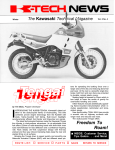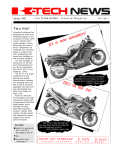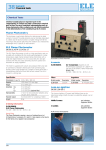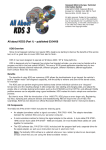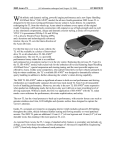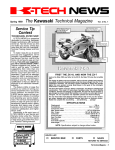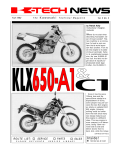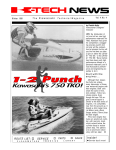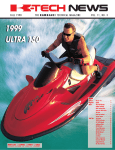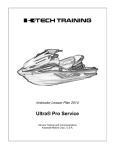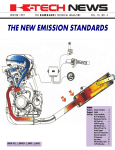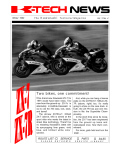Download K-Tech News Vol.6 No.3
Transcript
Fall 1993 The Kawasaki Technical Magazine Vol. 6 No. 3 by Patrick Kelly Instructional Designer/ Instructor First the Z-l. Then the 900 Ninja®. Both became legends in their own time, setting standards for motorcycles for years to come and putting an indelible stamp on the history of motorcycling. Now, there promises to be another legendary Kawasaki 900—the ZX-9R. The ZX-9R, officially designated the ZX900-B1, is based on the ZX750L/M. It is engineered to offer the latest in handling, braking and suspension while at the same time providing a high level of comfort, fit and finish. The ZX-9R’s powerful engine is basically a bored and stroked version of the ZX-7 engine. The bore goes from 71mm up to 73mm and the stroke goes from 47.3mm to 53.7mm giving a displacement of 899cc. To handle the increased displacement and torque, the main bearings and rod bearings are increased in diameter by 1mm. The cases are also redesigned to clear the increased stroke and the crankcase bolts are increased in diameter 1mm to increase the clamping force of the crankcase by 32 percent. Because of the ZX9R’s larger bore, a closed deck cylinder with wet liners is used instead of the CONTlNUED ON PAGE 2 ROUTE LIST.- o P L E A S E SERVICE R E T U R NT O o PARTS S E R V I C E o L I B R A R Y SALES Inside! n Service tips & more! Power ... CONTlNUED FROM PAGE 1 ZX-7’s open deck cylinder with dry liners. The ZX-9R’s engine retains the same compression ratio as the ZX-7’s (11.5:1) and also utilizes the same intake valves, exhaust valves and intake and exhaust camshafts. Although the transmission gear ratios remain unchanged from the ZX750-L, the primary gear ratio is changed from 1.754:1 to 1534:1. The clutch is also revised slightly to handle the ZX9R’s massive torque. The driving plate friction material is now paper-based instead of cork-based to help resist deformation from heat. Stronger clutch springs are also used to increase the torque capacity. To reduce noise generated from the engine, a silent cam chain is used instead of the ZX-7’s roller chain, and a rubber damper is added to the outside of the right side of the cylinder. Twin ram air ducts below the headlight feed fresh air over the frame rails to the airbox. (BELOW) ZX-9R’s unique exhaust crossoverpipe for improved torque output. 2 K-Tech News l Twin ram air ducts located below the headlight feed fresh cool air back around the inside of the ‘airing and over the frame rails to the airbox underneath the fuel tank. The air flows through a large air cleaner element (15 percent larger than the ZX7’s) to Keihin CVKD 40mm carburetors (up from the ZX-7’s 38mm carbs). A resonance box is connected to each ram air duct to lower intake noise. The ZX900-B uses a digital ignition system which limits rpm to 11,700. This new ignition system fires unique double-electrode spark plugs which improve combustion efficiency at low and middle engine speeds. Exhaust gasses exit this new engine package through an exhaust system based on the ZX-7’s. Unique to this system is a crossover pipe which connects all cylinders together for improved Iowand mid-range torque, and rubber mounting not only at the silencer but underneath the engine as well for reduced vibration and increased durability. The ZX-9R’s main frame is similar in construction to the ZX-7’s, using pressed aluminum sheets welded together and then joined to cast sections at the steering stem and swingarm pivot. This frame construction allows the frame to have maximum strength and rigidity with the least weight possible. The main differences from the ZX-7’s frame are a larger cast piece at the swingarm pivot and two aluminum downtubes underneath the engine. The two removable downtubes are a necessity since the ZX9R’s engine is rubbermounted in front for less vibration. The ZX-9R’s suspension is a recalibrated version of the ZX-7R’s fully adjustable suspension. Up front are 41 mm inverted forks with 12-way rebound damping adjustment, seven-way compression damping adjustment, and threaded spring preload adjusters. The fork springs are buffed on the outside to eliminate “break in” and the fork bushings are chamfered to eliminate stiction. In the rear, a nitrogencharged gas shock with a remote reservoir is used. This shock has 20-way compression damping adjustment as well as fourway rebound damping adjustment. Spring preload is adjusted with a threaded collar and ride height is adjusted by a threaded upper shock mount. The Uni-Trak linkage characteristics are identical to the ZX-7R’s, and the swingarm, with the exception of longer chain adjusters, is identical too. Braking chores up front are handled by dual 320mm discs gripped by four-piston calipers. The calipers use two pistons of the same bore on each side of the disc. In the rear, a single piston caliper is used along with a 230mm disc. A unique feature of the rear brake system is that the caliper bolts directly to the swingarm and no torque rod is used. The ZX-9R rides on the same, wide 17-inch rims as the ZX-7. Tires are ZR rated radials, 120/7017 at the front and 180/5517 at the rear. Although the ZX-9R offers “racer replica” performance, it does not do so at the expense of refinement and rider comfort. The handlebar position, footpeg location, and seat are all designed with both function and comfort in mind. The fairing is larger than the ZX7’s, providing improved protection from wind and rain. The inner portion of the cowling is painted for a sophisticated look. Clutch and brake levers are four-way adjustable for rider preference. There is a handy storage space for a lock under the seat. Instrumentation in- cludes a fuel gauge along with a speedometer, tachometer, dual tripmeters and a water temperature gauge. Welcome the ZX-9R to the Kawasaki Ninja family. The power and precision of the new ZX-9R promise to set new standards for motorcycles to come, and stir the passion of motorcycling for another generation. o A new radiator increases the cooling capacity over the ZX-7 by 11.5 percent. (BELOW) To save weight, the rear brake caliper is bolted directly to the swingarm. The Technical Magazine 3 l Fall 1993 Vol. 6 No. 3 ©1993 Kawasaki Motors Corp., U.S.A. (KMC). All rights reserved. K-Tech News Staff Publisher Kawasaki Tech Services Publications Manager Don Church Executive Editor Gary Herzog Editor-in-Chief Gregg Thompson Communications Editor Patrick Kelly Regional Editors North and East Fred DeHart Central and South Walter Rainwater Contributors David Corey, Randy Davis Keith Pestotnik, David Pyle, Ray St. John Graphics/Production Graphic Art Gregg Thompson Copy Editor Pat Shibata Production Nickless Communications Published by Kawasaki. All suggestions become the property of KMC. Sending a service suggestion gives Kawasaki permission to publish and/or use it without further consideration. Specifications subject to change without notice. 4 K-Tech News l Technical training survey results are in by Ray St. John Question 2: We asked Supervisor, Technical Writing During the last week in July this year, the Service Training and Communications Department at Kawasaki mailed out a survey form. Its aim? To find out what you want from this winter’s technical training season, and what you thought of the recently completed Service Contest. Here is a summary of the results: you which training subjects you wanted most and you said electrical troubleshooting. (We hear you!) Next we had a fourway tie between motorcycle fuel systems, periodic maintenance procedures (how to change spark plugs, clean air filters, adjust chains, set valve lash, and so on), JET SKI watercraft service, and motorcycle engines (ZXs, V-twins, and all the rest). Question 1: The video- Question 3: Apparently, tape everybody most wants to see is on engine diagnostics, including twostroke pressure and vacuum testing, finding oil leaks, oil pressure and compression testing, and carburetor vs. ignition problems. Next in popularity is a tape on power trains, with segments on motorcycle transmissions and final drives, and ATV automatic clutches, reverse, and dual-mode and limited slip differentials. A lot of you voted for a tape on the 750 JET SKI® watercraft covering engine disassembly and assembly, carburetion and other new features. A fair amount of interest was also expressed in MULE™ 2500 series service. no one has a problem with the shorter technical training season. Questions 4-7: It looks like you want the Service Contest to have fewer questions per segment and you want it presented in the winter when you have the time to work on it. Watch for some revisions here. Question 8: There were very few additional comments, but one stood out: “Thanks for listening.” We have one thing to say in return: “Thanks for letting us know what you want from the Service Training and Communications Department!” o The parts microfiche revised ... Grid A-2 of the parts microfiche lists P/Ns of the technical publications available for the product covered on that fiche. To clarify the service manual vs. supplement question, we have changed the grid layout to tell you what model the base manual covers so it won’t be a surprise when it arrives at your store. This will make it easier to explain to your customer why you ordered a KL600 manual for his KL250D and why he needs the supplement as well. - David Pyle “Charging and Starting Systems” video now available A new videotape from the Technical Training Department covers the theory of operation of most of Kawasaki’s charging and electric starting systems in just 18 minutes. It will be mailed automatically to all Technical Training Video Club members. The samples of systems covered in the video are drawn from Kawasaki’s line of motorcycles and watercraft. The information, though, is applicable to any charging or starting system on any Kawasaki product, so the tape will certainly be a valuable training aid for utility vehicle and generator technicians, too. The “Kawasaki Charg- ing and Starting Systems Troubleshooting Manual” will be available soon as a companion to the video. The manual will include a self test to be sent to Kawasaki for grading. The technician will receive a certificate of completion. - Ray St. John This just in ... K-Tech News Editor and long-time Hot Line Sr. Technician Gregg Thompson was recently promoted to Hot tine Supervisor. He will continue to edit K-Tech and answer calls as his schedule allows. Congrats, Gregg! Service manual supplement system If you’ve been reading K-Tech News regularly for the last few years, you’ll surely recognize most of this article. We’ve revised the information in the table below to bring you up to date. - Ed. S ome Kawasaki models need one service manual and some need two. Why is this? Well, in the beginning, there is only one service manual which includes all the information the technician needs to maintain and repair a given model motorcycle, watercraft, utility vehicle or generator. Service Manual Supplements and Base Manuals Motorcycle Model Supplement P/N Base Manual P/N Model of Base Manual KX60-B6/7 99924-1123-51 99924-1094-01 KX60-B4 KX80-L2/3, N2/3 99924-1123-51 99924-1094-01 KX80-L1, -N1 KX125-G1 99924-1116-51 99924-1101-01 KX125-F1 KDX200-E2~4 99924-1136-51 99924-1114-01 KDX200-E1 EL250-B2~4 99924-1093-51 99924-1066-01 EX250-E1 EL250-E1 99924-1093-52 99924-1066-01 EX250-E1 EX250-F2~7 99924-1109-54 99924-1066-01 EX250-E1 KDX250-D1~3 99924-1143-51 99924-1114-01 KDX200-E1 KL250-D2~10 99924-1051-03 99924-1050-01 KL600-A1 KX250-G1 99924-1116-51 99924-1101-01 KX250-F1 EN500-A1~5 99924-1125-51 EX500-A1~7 99924-1082-53 99924-1056-04 99924-1056-04 EN450-A1 EN450-A1 KX500-E1 99924-1116-51 99924-110101 KX500-D1 KX500-E2~5 99924-1132-52 99924-1101-01 KX500-D1 KL600-B1 99924-1063-51 99924-1050-01 KL600-A1 ZL600-A1~2 99924-1073-51 99924-1055-04 ZX600-A1 ZX600-C1~4 ZX600-E1~4 99924-1081-52 99924-1055-04 ZX600-A1 99924-1116-51 99924-1128-02 ZX600-D3 KL650-A1~7 99924-1080-52 99924-1050-01 KL600-A1 ZX750-H2 99924-1126-51 99924-1112-01 ZX750-H1 ZX750-L1~2 99924-1160-51 99924-1139-02 ZX750-J1 ZX750-M1~2 99924-1160-51 99924-1139-02 ZX750-K1 ZL900-A1~2 99924-1077-51 99924-1048-05 ZX900-A1 ZL1000-A1 99924-1077-51 99924-1048-05 ZX900-A1 ZX1100-C1~4 ZG1200-B1~7 99924-1127-52 99924-1089-52 99924-1098-02 99924-1064-01 ZN1300-A1~6 99924-1037-03 99924-1015-05 ZX1000-B1 ZG1200-A1 KZ1300-A1 Base Manual P/N Model of Base Manual ATV Model Supplement P/N KLF185-A1A/A2 99924-1076-51 99924-1058-01 KLF185-A1 KLF300-B1~7 99924-1100-51 99924-1057-02 KLF300-A1 KLF300-C1~6 99924-1117-51 99924-1057-02 KLF300-A1 Base Manual P/N Model of Base Manual JET SKI® Model Supplement PIN JS300-A1~5 99924-1070-51 99924-1059-02 JS300-B1 JS440-A8~A16 99924-1091-52 99963-0054-02 JS440-A1 JS550-A3~8 99924-1075-51 99963-0051-01 JS550-A1 JS550-C1~3 99924-1148-51 99924-1120-01 JS550-B1 JF650-B1~6 99924-1122-53 99924-1069-06 JF650-A1 JS650-A1~4 99924-1087-53 99924-1069-06 JF650-A1 JS650-B1~4 99924-1147-51 99924-1069-06 JF650-A1 JH750-A1~2 99924-1155-51 99924-1156-01 JS750-A1 JH750-A3 99924-1177-51 99924-1156-01 JS750-A1 JH750-B1~2 99924-1177-51 99924-1156-01 JS750-A1 Take, for example, the KLF300-A1: The sturdy fourwheeler originally had a comprehensive service manual aII to itself. But it was followed by a similar all-terrain model, the KLF300-B1. To save time and reduce costs, the factory chose to produce only a service manual supplement covering the unique features of the B1 model. The supplement did not cover the basic information which originally appeared in the service manual for the older KLF300-A1 model. So you need two separate books to have all the information on the KLF300-B1: the KLF300-A1 service manual, which is called the “base manual,” and the KLF300-B1 service manual supplement. At left, the latest listing of base manuals and supplements available for motorcycles, ATVs and watercraft. o Service Contest #3 wrap-up and award-giving ... C ongratulations to those technicians who scored 85 percent or better on Service Contest #3, which was significantly tougher than the first two contests. Everyone whose name appears on the diploma printed on page 6 will receive a Snap-On mini flashlight with magnetic base and useful fiberoptic option. We want to offer congratulations again to the award winners of Contests #1 and #2, and our special thanks to everyone who participated in Kawasaki’s 1993 Service Contest. We hope to see you again in the 1994 Service Contest beginning next fall. - Don Church, Manager, Service Training and Communications Department Congratulations to the winners of Kawasaki Service Contest #3 who will each receive one of these trick Snap-On mini flashlights. The Technical Magazine l 5 Award Winners K-TECH NEWS Service Contest #3 TECHNICIAN David Bjork Gary Bustillos David Moon Doug Engie Mike Nyholm Rayburn Sumner Jamie White DEALERSHIP Capitol Kawasaki Kawasaki Country Leer’s Kawasaki Northern Kawasaki Northern Kawasaki Forsyth Kawasaki Rehmert Cycle LOCATION Columbia, S.C. Norco, Calif. Waterloo, Iowa Cloquet, Minn. Cloquet, Minn. Winston-Salem, N.C. Versailles, Ohio Gary Bustillos is Service Contest Grand Award winner Congratulations to Gary Bustillos for completing all three tests with the highest cumulative score in the 1993 Kawasaki Service Contest. Bustillos was presented with the Grand Award at Kawasaki Motor Corp., U.S.A. headquarters in Irvine, Calif. on Sept. 17. After being given a tour of KMC’s offices and the West Region Distribution Center, Gary was presented with his award by Henry Noda, president of KMC, and Gary Herzog, Director of Technical Services. What was Gary’s award? Well, inside the specially engraved mini Snap-On tool box were tickets for an expense paid visit to Kawasaki Mo6 K-Tech News l tors Manufacturing in Lincoln, Neb.. There he will be given a VIP tour of the first Japanese vehicle manufacturing plant established in the United States. We want to thank all of the Kawasaki technicians who participated in the 1993 Service Contest. We recognize that the investment of your time and effort was considerable. Now that the contest is over, you will be receiving your test results along with the correct answers for those questions you missed. If you have any questions or would like an explanation of the correct answers for some questions, please call your regional training instructor. The response to the service contest has been positive. With some modifications, we will start an- other contest in the fall of ’94. Keep those pencils handy! o (LEFT to RIGHT) Gary Bustillos, Director of Technical Services Gary Herzog, and KMC President Henry Noda. MULE™ 2510 high/low cable adjust by Randy Davis Product Quality Engineer S ome KAF620-A1 (MULE™ 2510) customers have experienced problems with their sub- transmission not wanting to stay in the low range while under load (as in going up a steep hill). Normally, what is needed is just a cable adjustment, but some dealers have ex- 1 - Put the High/ Low selector lever (on the dashboard) into “Low.” 2 - Raise the cargo bed and find the High/Low shift shaft lever on the subtransmission. 3 - Push on the lever end in a counterclockwise direction (toward the cable) to take up all the free play in the cable and selector lever. The slot for the pinch bolt should be lined up with the cast-in pointer (with the “L” mark) on the subtransmission case. 4 - Put the High/Low selector lever into “High” and check for free play in the cable by moving the shift shaft lever. There should be a small amount of free play. perienced trouble getting it adjusted so it fully engages (and thus stays in) both low and high ranges. If you run into a situation like this, adjust the cable as follows: the shaft before removing the lever so you can reinstall if in the same position on the splines; there is no mark from the factory. 5 - If the cable needs adjustment, it can be done at either the cable housing adjuster where it mounts to the bracket, or at the cable end where it’s attached to the shift shaft lever. The easiest place to adjust it is at the cable housing adjuster, but if there’s not enough adjustment available there, you will have to remove the shift shaft lever from the shaft in order to adjust the cable length. Be sure to mark To double check your adjustment, try the following method taken from the MULE 2510/2520 service manual : 1 - Start the engine and put the transmission shift lever into Forward (F) gear. Leave the engine idling while performing this check. from the center. It is hard to tell precisely but close is good enough. If it is not close, but you have performed the cable adjustment as described above, you may have to move the shift shaft lever one tooth on the shift shaft spline. o TIP Plastic repair kit I f you’ve been throwing away fairing parts, side covers and fenders for small cracks or broken mounting tabs, you might want to consider a different approach to save your customer some money: Kawasaki offers a plastic repair kit made by ThreeBond® Company that quickly and permanently repairs this kind of damage. The kit includes a large bottle of cyanoacrylate glue and a primer which allows the glue to adhere to the types of plastic used in making motorcycle and ATV parts. Also included are sandpaper, fiberglass cloth for reinforcing the repair, and an accelerator for rapid curing. The kit even includes some handy glue remover for cleaning the glue off your fingers (or for removing your forefinger from your thumb without surgery ...). The kit is relatively inexpensive, will do several repairs, and comes with good instructions. With a little practice, you will be able to make strong, clean repairs for a fraction of the cost of a new part (thus making your customer happy), and what you do charge will be virtually all profit. To get one of these kits, order P/N K61080-050. - Gregg Thompson 2 - Pull back the detent lock on the High/Low shifter on the dash. 3 - Starting with the High/Low shifter halfway between the High and Low detents, slowly move it upward until the gears begin to grind, and then downward until the gears begin to grind. 4 - The gears should each begin to grind about the same distance The Technical Magazine 7 l Pressure testing two-stroke engines: Your common practice? by Gregg Thompson Product Support Supervisor When you have a twostroke engine in your shop which is suffering from hard-starting, low power, a bad idle and/or poor throttle response, what’s the first thing you should do? Everyone knows the answer to that one: take a compression test. That holds true, of course, whether it’s a fourstroke or a two-stroke engine. But if its a two-stroke engine, there is something else you should do before taking the top end apart any time you have low compression! Low compression in a two-stroke engine often means there has been a seizure. When repairing a seized top end in a twostroke engine, a very important step in the repair process is to determine what caused the seizure in the first place. There are a number of things that can cause a seizure in a two-stroke engine, but one of the most common is an air leak. To find out if the engine you’re working on has an air leak, you must preform a crankcase pressure test. You need a completely assembled engine (less carburetor and exhaust pipe) in order to pressure test it! Once you’ve taken the cylinder off, you can no longer check that particular base gasket for leaks. (So if it was leaking and you didn’t check it before taking the 9 K-Tech News l barrel off, you’ll never know it had a problem.) And what if the bottom end has a leak? You sure don’t want to put the new top end together and then pressure test it only to find out a crankcase seal is leaking. In many cases, you can get away with lifting the head off, looking at the cylinder wall for seizure marks, and then putting the head back on to pressure test it, but play it smart and don’t take the cylinder off until you’ve pressure tested it. When pressure testing an engine, ideally you want it to be air tight, but a small amount of leakage is acceptable. We recommend the “6 lb./6 min.” rule-of-thumb: Pump the engine up to 6 psi and it should take at least 6 minutes for that pressure to bleed off. You should also vacuum test the engine in case there is a seal that is inclined to leak more in than it does out. When is compression low enough to warrant a pressure test? In most cases, our service manuals give extremely wide compression tolerances. For example, the new 750cc JET SKI® watercraft manuals call for 121187 psi. The truth is, if one of these engines was down 20 percent from the top of that spec (to, say, 150 psi), it could have a problem. If it’s the same on both cylinders, normal wear may be the cause and the symptoms might be fairly mild. But if one cylinder is 175 psi and the other is 150 psi, there may well have been a light seizure. Pressure testing the engine might help pinpoint the cause of the seizure and could therefore prevent a repeat failure. If you don’t already have a pressure tester in your shop, you can order one from Kawasaki using P/N T96000-001. This pressure/vacuum tester comes with a variety of plugs and gaskets to help you seal up the intake and exhaust ports on various engines. You will want to supplement these with some expandable freeze plugs that you can get in various sizes from your local auto parts store. Get one of these tools and then get used to using it. It should become one of the most valuable tools in your shop. o If you don’t already have one, you can order a pressure tester direct from Kawasaki (P/N T96000-001). Decal dilemma We often get calls from dealers asking if the part they need comes with the decal installed or does the decal need to be ordered separately. That’s a very good question, but there is an easy way for you to remember the answer: If the vehicle has two wheels, its body parts are shipped with decals. If the vehicle comes with four wheels or no wheels then its body parts are shipped without decals. This rule applies only to body parts and hulls. All other parts (swingarms, etc.) come without decals. Oh, and last but not least, don’t forget to order the warning labels for any applicable parts. - David Pyle A “more better” KLF300 replacement air filter by Gregg Thompson Product Support Supervisor I n the Summer 1992 issue of K-Tech News, we told you about a higher quality replacement air filter for KLF300s: The KAF300-A1 (MULE™ 500) filter, which has a foam sleeve over a paper element, fits all KLF300s as well as KLF220s we reported. Well, after a little more in-house investigation, we’ve found that the KLF400-B air cleaner is also interchangeable with these other models, and is really quite a bit better than the MULE 500 air filter for a couple of reasons. It has noticeably more paper in it which increases the filtering capacity while extending the life of the filter. And, both the foam outer sleeve and the paper inner element are available separately. (This will save the customer around $10 if all he needs to replace is the paper element.) Even if your customer needs both paper and foam elements, the KLF400-B parts are less expensive than the MULE 500 part. Less expensive and better filtration ... that’s a good combination! To get the KLF400 parts, order P/N 11013-1217 for the paper (inner) element and P/N 11013-1205 for the foam (outer) sleeve. When servicing this filter take note of the following: The factory doesn’t recommend oiling the foam outer sleeve. Reason? If the oil from the foam sleeve gets into the paper element, the paper element will be ruined. We have found that, while most oils will transfer to the paper element, Bel Ray air filter oil doesn’t. The bottom line is that oiling the foam sleeve will increase the effectiveness of the filter and the life of the paper element as long as the oil stays off the paper. If you oil the foam element, use an oil that doesn’t transfer to the paper, and use it sparingly. The KLF400-B uses a rubber gasket to seal the air cleaner element to the spigot in the air box. This gasket cannot be used in the KLF300, so use heavy grease to seal the air cleaner to the air box. Be sure to fill the gap at the pinch bolt with grease as well. o Making that bevel gear case cap stay put ... We’ve had many calls spread out over the last eight years from dealers having trouble making the cap (or seal) on a VN750 bevel gearcase stay put. Often, by the time they call, they have already tried several methods and adhesives with little or no success. The cap just keeps popping out while the customer rides the bike. Naturally, when the cap pops out, it results in a large oil leak ... and an unhappy customer. The trick to making the cap stay installed is to 1) use a new cap; 2) clean the inside of the bevel gear case seal holder with acetone or lacquer thinner; and then 3) apply cyanoacrylate (“super”) glue to the seal before installing it. The most common types of cyanoacrylate glue set up so fast that there isn’t much room for error when using them. We suggest you use a gel-type cyanoacrylate, which takes longer to set up and is much easier to work with in situations like this where instant bonding is not desirable. You can now order geltype cyanoacrylate glue di- rect from Kawasaki using P/N KSGGA for a small (.06 oz.) tube, or P/N TB1762B for a large (.71 oz.) tube. By the way, this same method should be used if one of these caps pops out of the bevel gear case on some other model, such as the old “ZL” series Eliminator. - Gregg Thompson The Technical Magazine l 9 TIP As promised: Mass quantiies of super glue! A n article in the last issue of K-Tech News (Vol. 6 No. 2, Summer 1993) explained the different types of glues you should use when installing rubber parts on Kawasaki JET SKI® watercraft. In that artide, we promised to get you a part number by which you could order geltype cyanoacrylate (“super”) glue in large enough quantities to install the large floor mats on our sitdown watercraft. ThreeBond of America, Inc., offers the right stuff in a 0.71 oz. tuba. (That’s over 10 times as much glue as you get in the more common smallersize containers.) But in addition to its availability in a large tube, this glue is handy because it stays where you put it and it goes off a little stower than regular super glues-you’ll have a little more time to get the mat where you want it before it grabs a hold of you and the boat! Order this glue from Kawasaki using P/N TBl762B. - Ed. 10 l K-Tech News Stubborn-shifting KLFs by Keith Pestotnik Rocky Mountain Kawasaki Over the years, I have received a number of calls from dealers about KLF300s that don’t want to shift from neutral into first. The common complaint is that they have to blip the throttle (rev the engine a little) to get it to shift out of neutral. Normally when the engine is idling in neutral, there is enough friction in the primary (centrifugal) clutch to turn it slowly. This of course causes the secondary (multi-plate) clutch and the transmission input shaft to turn slowly as well. This slow rotation of the input shaft allows the engagement dogs in the gears to mesh easily when the transmission is shifted into first gear. But if the shaft is not rotating and t h e ment engage- dogs clash, there’s no way it will go into gear until something causes the shaft to rotate...something like blipping the throttle enough to engage the centrifugal clutch just a little. In the KLF300 transmission, the needle bearing on the small end of the input shaft and the two needle bearings on the reverse shaft each have a steel race pressed into the crankcases. What I have found is that sometimes one or more of these races is not pressed all the way into its bore in the cases. The race then pushes against the thrust washer on the shaft causing just enough friction to stop the input shaft from turning at idle. The fix for this (other than just blipping the throttle to put it in gear), is to split the cases and drive each of these bearing races all the way into its bore. o VN1500 oil filter confusion by David Pyle, Parts Publications Specialist There has been some confusion regarding oil filters for the VN1500-A. There are now two different filters that are used which are not necessarily interchangeable. The filter used on the VN1500-A1 through A7 is P/N 16097-1061. The threads on this filter are recessed back into the filter body to clear the hex nut on the threaded oil pipe in these earlier engines. The VN1500-A8 has a straight-threaded oil pipe with no hex nut, so the oil filter for this engine (P/N 16097-1064) does not have the recessed threads. The bottom line is that the filter with the recessed threads (P/N 16097-1061) will fit all VN1500 engines, but the filter without the recessed threads (P/N 16097-1064) fits only the VN1500-A8. The first microfiche we issued that included the ’94 VN1500-A8 listed P/N 16097-1064 FITS ONLY VN1500-A6 incorrect oil filter information. That microfiche card was dated June 1993 and covered the VN1500A6/A7/A8. If you still have that microfiche anywhere in your dealership, please discard it. The corrected microfiche card is dated July 1993. o P/N 16097-1061 FlTS ALL VN1500s When the brakes do the bleeding, but you have the pain ... by Gregg Thompson, Product Support Supervisor B leeding hydraulic brakes can be a frustrating and time consuming project— especially if you don’t have any pressure or vacuum brake bleeding equipment at your shop. Probems are usually caused by little nooks and crannies inside the fittings and caliper(s) which can give air bubbles a place to hide from the flow of brake fluid. Also, when you manually bIeed the brakes by pumping up the pressure at the master cylinder and then bleeding it off at the fitting on the caliper, a relatively small amount of fluid is being pushed downward through the system. The air, however, would really like to float upward through he fluid, so as you pump he pressure back up at the master cylinder, the bubbles hat were pushed down the line have a tendency to float back upstream. It’s a “three steps forward, two steps back” situation. Pressure and vacuum bleeding equipment solves this problem by forcing a large quantity of fluid through the system in one direction with little or no interruption. If you don’t have any power bleeding equipment in your shop, try the following method the next time you have a tough brake bleeding job. This method overcomes most of the problems described above without the use of power equipment: 1 - Remove the caliper from its bracket. 2 - Place a large flat blade screwdriver between the brake pads, and pump the master cylinder until the pads grip the screwdriver. 3 - Take another screwdriver and spend a little time tapping on the hoses and any fittings or junction blocks in the line going up to the master cylinder. This helps dislodge any air bubbles in the system, and starts them moving up through the fluid. (An electric pencil works great for this: Just turn it on, place the pencil body against the various parts of the brake hydraulic system, and the vibration will loosen the air bubbles and cause them to rise in the fluid quickly.) 4 - Drain the master cylinder reservoir so it doesn’t overflow and then, as quickly as you can, pry the brake pads apart with the screwdriver forcing the piston(s) all the way back up into the caliper. This forces a large amount of fluid upward into the master cylinder. If the vehicle has dual discs, repeat the procedure with the other caliper. Make sure to put a piece of wood or Styrofoam in the first caliper so fluid doesn’t transfer from the second caliper back into it. 5 - Being careful to keep the reservoir topped off, pump the caliper(s) up with fluid again. 6 - Now, holding the caliper with the bleeder fitting at the highest point, open the bleeder slightly and pry the pads apart again. Any air left in the caliper will be forced out the bleeder. o 750 watercraft exciter coil diagnostic test data D ealers have been asking us for a good diagnostic test for the new JS/JH750 watercraft exciter coils. So we did some tests with a few meters on some boats and came up with some procedures and some numbers. Check the exciter coil in-circuit (that is, with all wires connected) AC voltage. It is easy to do this at the multiconnector just inside the electrical box. Perform the test with the spark plugs in the engine and the spark plug leads removed and grounded. Make sure the stop switch lanyard is in the switch (that is, in the run position). If the stop switch is n the off position (lanyard pulled out), your readings will be inaccurate. Crank the engine with the starter motor and probe the red and purple wires with your meter leads. Switch your meter leads on the wires and check again. With most meters, you will get 60-80 VAC one way and 9-12 VAC the other. Meters vary somewhat so you should probably check a couple of known-to-be-good ignitions if you can to see what your meter says. Note that some digital meters will actually read the higher voltage no matter which way the meter is connected. - Gregg Thompson The Technical Magazine l 11 Training Schedule East Region November 2-4 Engines 5 Precision Measurement and Diagnostic Tool Usage 9-11 JET SKI® Watercraft 23 Parts Department Operations Service Department Operations Modern Engine Theory 30 December 1-2 Fuel Systems 7-9 Troubleshooting Elec. Systems 14-16 JET SKI® Watercraft 17 Generator North Region November 15-16 Fuel Systems 17-19 Engines This time, less is more New and improved It’s back to work by Patrick Kelly by Walter Rainwater by Fred DeHart 9950 Jeronimo Road Irvine, CA 92718 (714) 770-0400 6110 Boat Rock Blvd. SW. Atlanta, GA 30378 (404) 349-2000 201 Circle Drive N., #107 Piscataway, NJ 08854 (201) 469-1221 T his years training season T he new training season thrills me: Our ’93-’94 training season will begin in Nov. after the Oct. dealer show in Dallas. Be sure to look at the schedule in this issue: Many of our classes have been changed to include information on the exciting ’94 models. Dealers have requested it and Kawasaki Technical Training has responded: We plan to have a limited number of road schools this season, highlighting information on the ’94 models. Look for separate schedules and announcements about road schools in your area. The Service Contest was enthusiastically received this past season, and so we will continue it— with a few changes in format, probably, just to keep things interesting. Watch for more details! o Just a reminder that one Team Green class will again be held in both the North and East regions this training season. If you want to attend, be sure to sign up for the first one you see scheduled. The class will not be held again this season. Another reminder to all technicians who have the occasion to speak with our very capable Hot Line staff: Make sure you know the specific year and model of the Kawasaki product you are working with. Have the mileage and frame number available before you call. If you are calling for authorization on a completed job, be sure to have a claim number and the job codes available. The Hot Line staff can answer more calls if they get all this info without waiting. o will begin in November and end in April instead of beginning in October and ending in May as it has in previous years. At first, this may seem as though we are offering you less, but in actuality we are trying to offer you more. Let me explain: We have found that Oct. and May are typically our slowest months in the training season. Sometimes there are so few students that we end up having to cancel a class. Shortening the training season gives students more time to make plans to attend, and should have the added benefit of filling up the classes. A full class (anywhere from eight to 12 students) gives everyone the opportunity to learn from each others’ experiences. o 12 K-Tech News l Central Region December 7 Modern Engine Theory 8-10 Engines 13-15 JET SKI® Watercraft 16 Service Department Operations South Region November Engines 1-3 Modern Engine Theory 4 Precision Measurement and Diagnostic Tool Usage 9-11 JET SKI® Watercraft 15-16 ATV Service 17-16 MULE™ Service 29-30 Troubleshooting Elec. Systems December 1-2 ATV Service West Region November Precision Measurement and 1 Diagnostic Tool Usage 2-3 Engines 4 Modern Engine Theory 8-10 JET SKI® Watercraft Service Department Operations 11 16-18 Troubleshooting Elec. Systems 22-23 Fuel Systems 24 Generator 29-30 MULE™ Service December ATV Service 1 2 Precision Measurement and Diagnostic Tool Usage 13-15 JET SKI® Watercraft Service Department Operations 16 20-21 Fuel Systems 22 Generator













